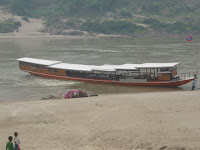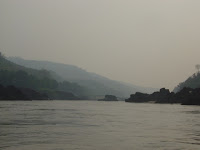









In order to get more comfort on my second day, I decided to book for a seat in the private boat of Luang Say lodge. This 34 metre river barge was appointed with everything for comfort, satety and enjoyment, with open air seating, a bar, toilet factilities and galley. Meals, snacks and drinks were served so it was the perfect way to relax and enjoy a unique and romantic voyage, not to compare with the overloaded boat from the first day. We were only 7 people of the boat! So it was really worth the money. On our way I saw villages along the river of several ethnic groups, one of which we also stopped by. The village had its own temple with monchs and an entire population of only 180 people. The houses were quite large, since entire extended familiy of three generations live together. Solid and splendid houses on thick teak pillars three metres above the ground. In the shade under the houses, men repair the long-tailed speedboats which ply the river, and with large hand operated looms women weave the famous lao-loung cloth with its wonderful colours and designs. Further on our trip we stopped at the magnificant cave temple of Tham Ting. There are two caved burrowing into the cliff, reached by a steep path which winds up the solid rock. The caves contain thousands of buddha images, and are of great religious importance. At Laos New Year, pilgrimages of Lao people go by boat to the caves and perform the washing ceremony of all the old buddha images. Previously it was performed by the King and members of the Royal Family but now is performed by the Governor of Luang Prabang and local families. We reached Luang Prabang after another 7 hours on Mekong river.
























